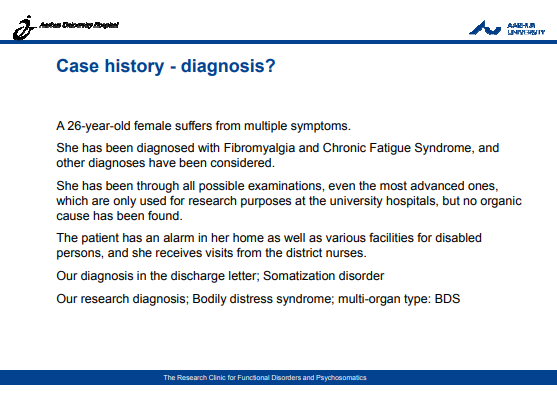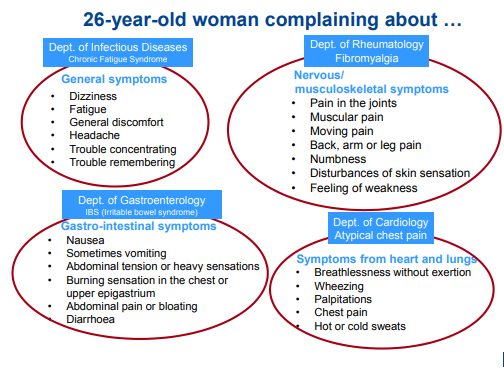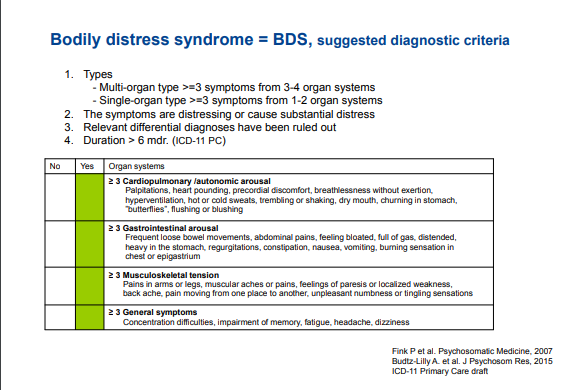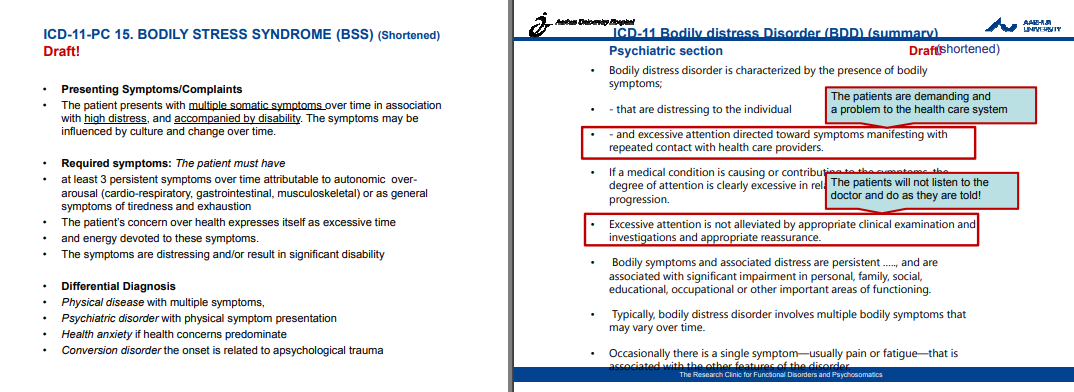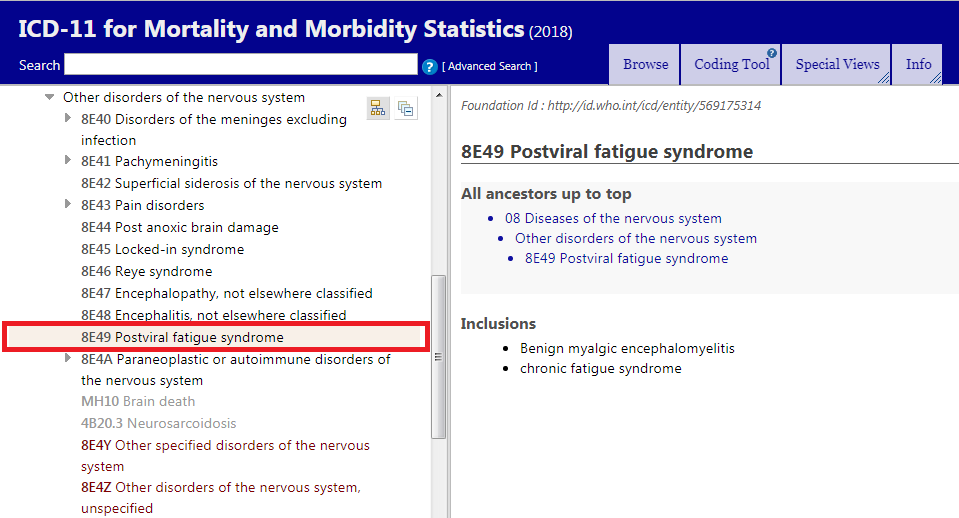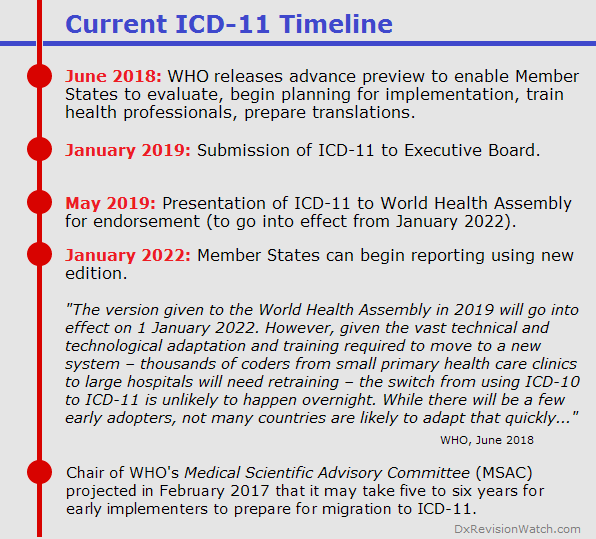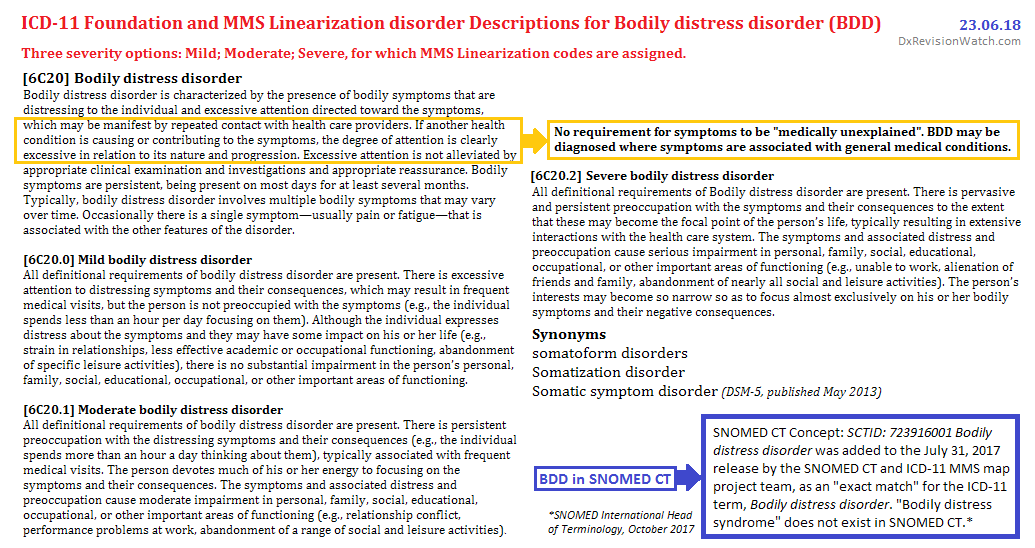This is the fourth in a series of posts about SNOMED CT:
Post #4 Change of Parent for Chronic fatigue syndrome and its Synonym terms
Post #1 Introduction to SNOMED CT clinical terminology system
Post #2 Concept terms of interest to us
Post #3 Inclusion of ICD-11's Bodily distress disorder
Post #5 Confirmation of change of Parent for CFS and its Synonym terms (to be posted on July 31, 2018)
Change of Parent for SNOMED CT Concept: SCTID: 52702003 Chronic fatigue syndrome (disorder)
As set out in
Post #1 of this series, the SNOMED CT terminology system is structured differently to ICD-10 and ICD-11. SNOMED CT doesn't use a chapter system. Instead, disease and disorder Concept terms are arranged hierarchically under a series of Parent terms which provide "Relationships" for the Concept term.
SNOMED CT is made available under license. But a public browser for the International Edition and a number of the country editions can be viewed here:
http://browser.ihtsdotools.org/
The
SNOMED CT UK Edition is managed by NHS Digital, as the designated SNOMED CT UK National Release Centre. A public browser can be viewed here:
https://termbrowser.nhs.uk/
Since April 2018, SNOMED CT UK Edition has been the mandatory clinical terminology for use in NHS primary care, replacing the Read Code (CTV3) terminology, which is now retired.
Secondary Care, Acute Care, Mental Health, Community systems, Dentistry and other systems used in the direct management of care of an individual are scheduled to adopt SNOMED CT as the mandatory clinical terminology before 1 April 2020.
History of CFS, ME in SNOMED CT:
In SNOMED CT, the Concept term is
Chronic fatigue syndrome (
Concept SCTID: 52702003).
Prior to July 2015,
Chronic fatigue syndrome and its Synonym terms had been assigned under two Parents:
Multisystem disorder
Mental disorder
Following discussions in 2015 between the Countess of Mar, NHS Digital (then HSCIC) and SNOMED International, it was agreed that the
Mental disorder Parent would be removed from CFS and that this would be actioned for the July 2015 release of the International Edition.
At the same time, a change was made for the listing of
Postviral fatigue syndrome (a change which had not been requested by the Countess of Mar).
Postviral fatigue syndrome had been listed under Children to CFS. But PVFS was assigned a new SCTID code of its own and moved under new Parent:
Post-viral disorder, under Parent:
Post-infectious disorder.
The Multisystem disorder Parent was retired for the January 2018 release:
In 2017, SNOMED International terminology managers decided that the Concept:
Multisystem disorder was not sufficiently specific for the purposes of their terminology and that the term should be retired from use across the entire system.
Concept SCTID: 281867008 Multisystem disorder (disorder) had 90 Children Concepts located under it, including CFS.
So its retirement for the January 2018 release had implications for all of these terms - not just for CFS.
When the
Multisystem disorder Parent was retired, many of these 90 terms were relocated under more specific Parents. A few of these terms, including CFS, were not re-assigned under a new Parent.
(A small number of these 90 terms have been retired from the system altogether because they were historical terms, or duplicates, or were considered to be ambiguous terms that were unsuitable for inclusion.)
The removal of the
Multisystem disorder Parent left CFS without a body system or aetiology Parent. Now, its only Parents were:
Parents
Clinical finding (finding)
This was not ideal. But it presented a good opportunity to request that a more specific Parent should be assigned to CFS.
A formal request and a rationale text for adding the Parent:
Disorder of nervous system to CFS was drafted by me and submitted via Forward-ME to the UK National Release Centre.
A couple of weeks later, we were advised that this request for a change had been entered into the International Edition's peer review process and had been approved. The change is scheduled to be actioned for the July 31, 2018 release.
This change would then be incorporated into the next release of the UK Edition (October 01, 2018) and in all the country editions, as they publish their new releases (from September 01 onwards, on a staggered schedule).
If this change goes forward without any unforeseen delays, then for the July 2018 release, CFS should display like this in SNOMED CT:
Parents
> Disorder of body system (disorder)
> Disorder of nervous system (disorder)
Chronic fatigue syndrome (disorder) SCTID: 52702003
52702003 | Chronic fatigue syndrome (disorder) |
Myalgic encephalitis
Myalgic encephalopathy
Iceland disease
Benign myalgic encephalomyelitis
Chronic fatigue syndrome
Myalgic encephalomyelitis syndrome
ME - Myalgic encephalomyelitis
Myalgic encephalomyelitis
CFS - Chronic fatigue syndrome
Chronic fatigue syndrome (disorder)
Children
There are no Children under CFS in the International Edition. But the UK Edition includes three severity specifier options:
Mild CFS; Moderate CFS; Severe CFS. These are marked with the Union Flag symbol to indicate that inclusion of these three additional severity terms is specific to the UK Edition.
(I intend to establish in what year the three severity specifiers were added to the UK Edition; who submitted the request for their addition; whether they are optional; and by what means clinicians are to determine which of the three severities to specify.)
For SNOMED CT,
SCTID: 52702003 Chronic fatigue syndrome (disorder) was already cross mapped to ICD-10 G93.3. This additional Parent would consolidate that relationship.
Caveat:
This request for addition of Parent:
Disorder of nervous system (disorder) has been accepted but the draft content for the July 31, 2018 release has not yet been finalized. The July 31, 2018 Release has now reached the
BETA Release stage.
Member organizations are able to download the Beta release files to perform a technical evaluation of the core files before the next International Edition release package is distributed to Members on June 30, 2018 (ie a full month before the July release is implemented).
I will update in
Post #5 Confirmation of change of Parent for CFS and its Synonym terms when the content of the July 2018 Release has been finalized and when the July Release is available on the public browser.
I'll also confirm that the three severity specifiers for BDD have been incorporated into the July Release (See
Post #3).

